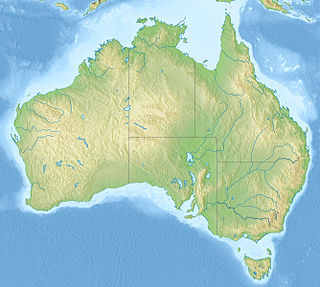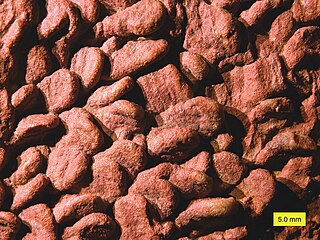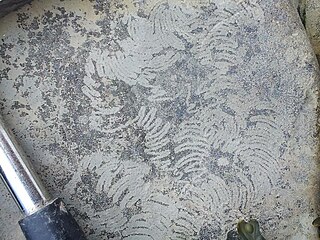
A trace fossil, also ichnofossil, is a fossil record of biological activity but not the preserved remains of the plant or animal itself. Trace fossils contrast with body fossils, which are the fossilized remains of parts of organisms' bodies, usually altered by later chemical activity or mineralization. The study of such trace fossils is ichnology and is the work of ichnologists.

In geology, a graded bed is one characterized by a systematic change in grain or clast size from one side of the bed to the other. Most commonly this takes the form of normal grading, with coarser sediments at the base, which grade upward into progressively finer ones. Normally graded beds generally represent depositional environments which decrease in transport energy as time passes, but these beds can also form during rapid depositional events. They are perhaps best represented in turbidite strata, where they indicate a sudden strong current that deposits heavy, coarse sediments first, with finer ones following as the current weakens. They can also form in terrestrial stream deposits.
Trace fossils are classified in various ways for different purposes. Traces can be classified taxonomically, ethologically, and toponomically, that is, according to their relationship to the surrounding sedimentary layers. Except in the rare cases where the original maker of a trace fossil can be identified with confidence, phylogenetic classification of trace fossils is an unreasonable proposition.

Zoophycos is a somewhat cosmopolitan ichnogenus thought to be produced by moving and feeding polychaete worms.

The Tumblagooda Sandstone is a geological formation deposited during the Silurian or Ordovician periods, between four and five hundred million years ago, and is now exposed on the west coast of Australia in river and coastal gorges near the tourist town of Kalbarri, Kalbarri National Park and the Murchison River gorge, straddling the boundary of the Carnarvon and Perth basins. Visible trackways are interpreted by some to be the earliest evidence of fully terrestrial animals.

Skolithos is a common trace fossil ichnogenus that is, or was originally, an approximately vertical cylindrical burrow. It is produced by a variety of organisms in shallow marine environments globally and appear as lineated features in sedimentary rocks.

Rhizocorallium is an ichnogenus of burrow, the inclination of which is typically within 10° of the bedding planes of the sediment. These burrows can be very large, over a meter long in sediments that show good preservation, e.g. Jurassic rocks of the Yorkshire Coast, but the width is usually only up to 2 cm, restricted by the size of the organisms producing it. It is thought that they represent fodinichnia as the animal scoured the sediment for food.

An ichnofacies is an assemblage of trace fossils that provides an indication of the conditions that their formative organisms inhabited.

The "Cambrian substrate revolution" or "Agronomic revolution", evidenced in trace fossils, is the diversification of animal burrowing during the early Cambrian period.

Diplocraterion is an ichnogenus describing vertical U-shaped burrows having a spreite between the two limbs of the U. The spreite of an individual Diplocraterion trace can be either protrusive or retrusive. Some ichnospecies have both types. The presence/absence of funnel-shaped openings should not be used as an ichnotaxobase due to the high probability that the upper portions of the trace may have been eroded away. Observation of the orientation of Diplocraterion in the field is frequently used to determine the way up of rock strata at outcrop.

A microbial mat is a multi-layered sheet of microorganisms, mainly bacteria and archaea, and also just bacterial. Microbial mats grow at interfaces between different types of material, mostly on submerged or moist surfaces, but a few survive in deserts. A few are found as endosymbionts of animals.

Ophiomorpha is an ichnotaxon, usually interpreted as a burrow of an organism living in the near-shore environment. The burrow lining is more or less smooth on the inside, and densely to strongly mammalated or nodose on the outside, due to the packing of fecal pellets for support of the burrow. Branching is irregular but Y-shaped where present. It is often considered part of the Skolithos ichnofacies, where it has occurred since the early Permian, though it has also occurred in deep water settings since the Late Jurassic, such as well-oxygenated turbidites.

Fugichnia is an ichnogenus of trace fossil characterized as "escape burrows" that are formed as a result of organisms' attempts to escape burial in sudden high-sedimentation events like turbidity currents. The burrows are often marked with chevron patterns showing the upward direction the organisms were tunneling.
Macaronichnus is an ichnogenus of trace fossil.

Helminthopsis is the ichnogenus of a type of trace fossil that is found preserved on the bedding planes of fine-grained sedimentary rocks. It is characterized by short, curvilinear, non-branching, parallel-sided, unlined traces on bedding surfaces. It is thought to represent the submarine feeding trails of an invertebrate organism that worked the surface of muddy substrates in search of food. Because Helminthopsis traces never cross over themselves, the ichnogenus is distinguished from similar traces assigned to the Gordia ichnogenus. The similar sounding, but now obsolete, ichnogenus Helminthoida refers to a somewhat similar trace characterized by regular, back-and-forth meanders, whereas Helminthopsis traces are irregular.

Haplotichnus is an ichnogenus of invertebrate trace fossil that was erected by S.A. Miller in 1889. Buatois et al. (1998) proposed that Haplotichnus should be synonymized with Gordia because both exhibit a looping course with self-crossing. Other researchers, such as Wang et al. (2009), have maintained the distinction between the two ichnogenera because Haplotichnus has sharp bends, whereas those of Gordia are not sharp. Most recently, Getty and Bush (2016) synonymized Haplotichnus with Treptichnus due to the presence of bifurcating projections at the bends. Other features, such as the looping course of the trace, thought to distinguish Haplotichnus from Treptichnus, are actually seen in one of the syntypes of Treptichnus, further supporting Getty and Bush's (2016) synonymy.

Chondrites is a trace fossil ichnogenus, preserved as small branching burrows of the same diameter that superficially resemble the roots of a plant. The origin of these structures is currently unknown. Chondrites is found in marine sediments from the Cambrian period of the Paleozoic onwards. It is especially common in sediments that were deposited in reduced-oxygen environments.

Nereites is a genus of trace fossil. Modern tracemakers of incipient Nereites include worm-like organisms, horseshoe crabs and hermit crabs. Traditionally, two models have been proposed for Nereites:
- in the ‘worm model’, Nereites is a feeding burrow produced by wormlike organisms, probing and backfilling laterally
- in the ‘arthropod model’, the characteristic lobes are pressure-release structures made by arthropod legs. According to this interpretation, Nereites is a locomotion trail

Pholad borings are tubular burrows in firm clay and soft rock that have been created by bivalve molluscs in the family Pholadidae. The common names of clams in this family are "pholads", "piddocks", and "angel wings"; the latter because their shells are white, elongated and tend to be shaped like a wing and have sculpture somewhat reminiscent of a wing.

Muensteria is the ichnogenus of a type of trace fossil that is found in sedimentary rocks, and is thought to represent the horizontal burrow of a marine invertebrate organism. It is a horizontal, non-branching, unlined, tube-like burrow characterized by menisci, which are concave to flat laminae within the burrow created as the organism packs sediment and fecal material behind it when moving forward in the burrow. Muensteria is one example of a meniscate burrow.



















